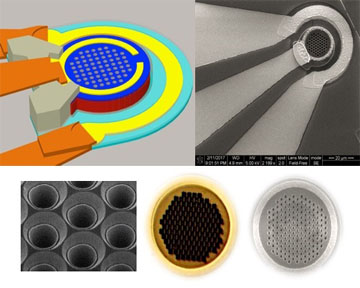
Tapered black holes in silicon, about 1 μm in size, can trap photons and act as a photodetector for high-speed data connections. Top left: Schematic of the ultrafast photodiode. Top right and bottom left: Scanning electron micrographs of the photodiode and its funnel-shaped holes. Bottom right: Conventional and SEM images of the photodetector. [Image: M. Saif Islam, UC Davis]
Out in the universe, black holes exert such strong gravitational pull that light can never escape them. Now, U.S.-based scientists have developed a silicon photodetector with tiny holes that can trap photons, in order to boost in optical communications speeds (Nature Photon., doi:10.1038/nphoton.2017.37). The work, led by electrical engineer M. Saif Islam at the University of California, Davis, USA, is part of a continuing effort to integrate optical communications channels throughout data centers, down to the chip-to-chip and intra-chip levels.
Why silicon photodiodes
Silicon photodiodes work well at visible wavelengths, but silicon’s absorption coefficient drops precipitously in two key infrared bands: the 840-to-860-nm region used in short-haul multimode communications, and the 850-to-950-nm band that has been proposed for short wavelength-division multiplexing techniques. To counteract the weak absorption, silicon photodiodes must be built with thick layers, which slows down signals, or alternatively, must incorporate other, more expensive semiconductors that don’t integrate well with silicon during circuit fabrication.
Islam and his colleagues designed the all-silicon photodetector for compatibility with cost-conscious very-large-scale integration (VLSI) manufacturing processes in the electronics industry. Through the layers of the p-i-n diode (with the n-type semiconductor region at the top), the researchers etched a periodic array of tiny holes, some shaped as ordinary cylinders and others as miniature funnels. Light from a multimode fiber illuminated the photodetector from the top.
Numerical simulations suggested that illumination from above would induce lateral field propagation in the photodiode; in other words, photons falling into the holes would be pulled sideways into the 2.0-μm-thick silicon. Thus, the light passes through much more silicon, enhancing the silicon’s absorption efficiency.
Short reach, high speeds
Experiments with an 850-nm pulsed fiber laser showed that the photodiode had an impulse response of 23 ps, corresponding to a data-transmission rate of at least 20 Gbit/s. In the transmission range of 820 to 860 nm, its quantum efficiency exceeded 50 percent. According to the team, this technology could be useful for so-called “short reach” optical links of less than 300 m within data centers. Researchers at the University of California, Santa Cruz, USA, and W&WSens Devices Inc., USA, also contributed to the study.
